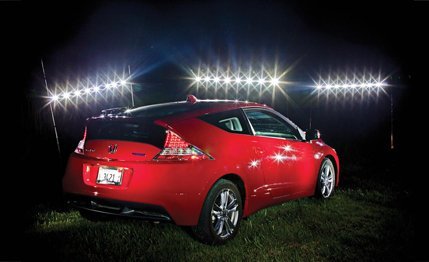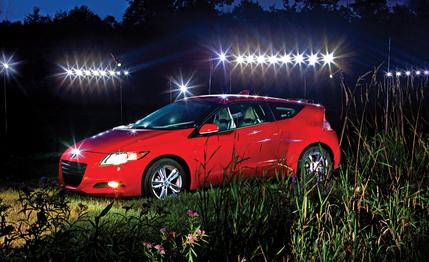 Road Test
Road Test


Since Honda began selling the Insight—the first hybrid vehicle in North America—way back in the concluding month of the 20th century, it has struggled to find a winning formula for the carbon-conscious hybrid crowd. That first odd-looking, all-aluminum Insight was a fuel-economy champ, but it offered little room for belongings and only one additional seat, forcing most would-be buyers to wait seven long months for the more practical Toyota Prius.
The 2003 Civic hybrid didn’t capture hybrid buyers’ apparent desire for something that looked different, that made a statement. The same can be said of the 2005 Honda Accord hybrid—and that V-6–powered sedan didn’t produce as big a bump in fuel economy as did the Civic.
Fast-forward five years to a completely new Insight—a low-drag, five-door wedge similar to the Prius. That Insight won a comparo against the Prius [“Mileage Maestros,” July 2009] mainly because it drove better, not because it was the more efficient hybrid.
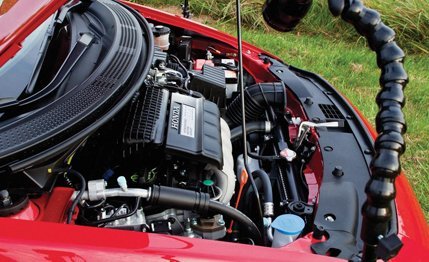

Apparently a lot of people missed that test—or perhaps they value the Toyota’s superior mileage and vastly larger back seat and cargo hold—because the Prius outsold the Insight more than 6 to 1 (80,141 to 12,115) during the first seven months of 2010. In fact, through 2009, Toyota sold more than three times as many Priuses as all Honda hybrids combined. So what must Honda do to jump-start its hybrid line? Try combining two paragons of its past?
Honda would like you to think of the 2011 CR-Z as the spiritual successor to its sporty and now iconic CRX of ’80s glory. But the Z is more of a two-seat Insight and thus the spiritual successor to the original, and now, ironically, much-sought-after Insight.
Underpinning the CR-Z are the same building blocks that compose the Insight and the 10Best-winning Fit. Compared with the Insight, the CR-Z’s wheelbase is 4.5 inches shorter, at 95.9; its 160.6-inch length is clipped by about a foot, though the Z is wider, at 68.5 inches, by 1.8.
However, some CRX similarities trickle into the new Z. Both are two-seat, three-door hatchbacks that, in other markets, are (or were) two-plus-two-seaters. And the Z’s flashy styling is inspired, in part, by that of the old X.
The beating heart of this hybrid is an electric motor, Honda’s familiar Integrated Motor Assist (IMA), sandwiched between a 113-hp, 16-valve SOHC 1.5-liter four-banger (the current Insight and Civic hybrids use a 1.3-liter) and the transmission. Its six-speed manual makes it the only hybrid with three pedals. An optional CVT adds $650.
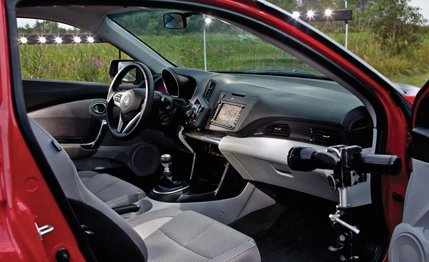
This gas engine, while identical in displacement to the current 117-pony four in the Fit, is really closer to the first-gen Fit’s 1.5-liter in the Honda L-series-engine family tree, according to Honda. This version of IMA is identical to the current setup in the Insight: a slender, 13-hp electric motor powered by 84 1.2-volt nickel-metal hydride batteries [see sidebar, below right]. The motor makes 58 pound-feet of torque, same as the Insight’s. Combined output is 122 horsepower and 128 pound-feet of torque. Adopters of the CVT must settle for 123 pound-feet.
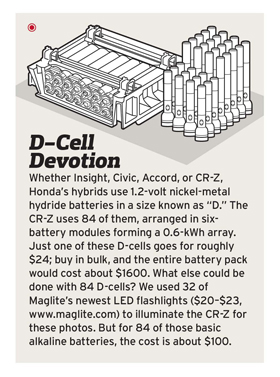
On paper, the Z is 100 pounds lighter than the Insight, at 2644, and 24 horses stronger, which translates to a 0.7-second advantage to 60 mph (9.6 seconds) as well as in the quarter-mile (17.2). But its acceleration is slower by a full second to 60 mph, compared with a 105-hp 1988 CRX Si, and 0.6 second behind in the quarter-mile. And don’t even get us started on the extra 558 pounds the CR-Z is packing.
According to the EPA’s test procedures, the six-speed CR-Z returns 31 mpg in the city and 37 mpg on the highway. With the CVT, it gets 35 and 39, respectively. Both the Insight (40/43) and the Prius (51/48) are more efficient. For the sake of comparison, the original Insight is rated at 49 mpg city and 61 mpg highway by the current standards—and that’s a big reason people still want them.
Under our supervision, the CR-Z returned 36 mpg, with single-tank honors going to a 40-mpg highway trek. That aggregate is only 2 mpg better than the comparo-winning Fit [“Ego Shrinkers,” October 2010] and 2 mpg poorer than the Insight from the July ’09 comparo, where we also saw a Prius average 42. None can top the observed 48 mpg of our long-term first-gen Insight.
The CR-Z slots between its siblings in both performance and efficiency, so it would seem to make sense for it to line up pricewise between the $15,650 2010 Fit and the $20,550 ’10 Insight (2011 figures are not yet available). But the Z’s cost lands right on top of the Insight’s, in base form, at $19,950. Add the CVT automatic to the CR-Z, and it is 50 bucks more than a base Insight. Our fully loaded EX model (tier-two additions include HID headlamps, Bluetooth phone capability, aluminum pedals and shift knob, and an upgraded stereo) whistles a tune of $23,310, including an $1800 navigation unit.
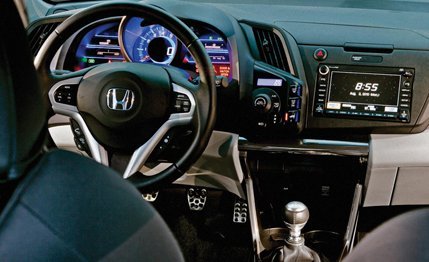
A buyer confined to a Honda showroom could get the more practical, more efficient five-door Insight for essentially the same money. Or, for a lot less money, there’s the Fit: slightly less efficient, but better in almost every way—and quicker. This will likely curse CR-Z sales no matter how good-looking it is.
But those who do opt for the stylish CR-Z will without doubt enjoy driving it. The car is filled with excellent Honda traits: perfect shifter, great ergonomics, superb chassis.
It may not have the power-to-weight ratio to compete with the old CRX, but the Z traverses blemished roads with poise. Road noise elevates the stereo-free cruising soundtrack to 71 dBA. Not exactly quiet but on par with other cars in its price range.
Inside, the well-laid-out cabin borrows switchgear and the nav unit from the community bin. The silver-cloth buckets sit low in the car, and a tilting-and-telescoping leather-wrapped wheel (another plus of the EX) and manually adjustable seat height deliver a comfortable driving position.
The hatch opens to a generous cargo area that will accept 13 cases of longnecks if the cargo partition (a hard-plastic folding shelf that, padded, would be the seatback for two-plus-two-market CR-Zs) is folded. This small bit of practicality is overshadowed by the Fit’s ability to hold 35 cases.
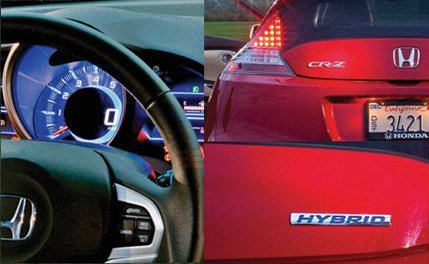
A digital speedometer floats in the middle of an analog tachometer in the center ring of the instrument binnacle. The instrumentation reveals the car’s fuel-economy mission. To the left of the helm lie three mode buttons: normal, econ, and sport. In normal and econ modes, a color-changing ring, nestled between the tach and the speedo (as in the Insight), helps the driver get the best possible gas mileage. The ring glows green at idle and then transitions to blue with hard acceleration. Keep the ring green with gentle throttle inputs for optimal fuel economy. In sport mode, the ring glows red, steering effort increases, and the throttle gets touchier. Be wary of using the econ setting in hot, humid conditions because, in this mode, the air conditioning tones down its frosting abilities, reducing the accessory’s economy-zapping draw.
Another efficient tool is the engine’s stop-start function, which Honda has tuned more aggressively this time. In the CR-Z, the engine cuts out when slowing to a stop as early as 20 mph. As soon as you reselect a gear, it fires back up without any intrusive vibrations.
Follow the shift strategy on the dashboard, and sixth gear is suggested before 40 mph. Engage sixth gear even earlier, and one anticipates unpleasant lugging, but there’s none. The electric motor’s additional torque boost at low rpm takes some strain off the gas engine.
Making the momentum game difficult is the gas engine’s slow march to its 6300-rpm redline. The neutral chassis can provide entertainment on two-laners, but bleed off too much speed, and getting the CR-Z back up to a velocity sufficient to reach its 0.85-g handling limit will take another corner, maybe two. Thankfully, the stability control is completely defeatable, and if you have the talent, the CR-Z will rotate under braking.
The electric power steering gives you all the quality feedback you might expect from a Chinese calculus professor—a poor trait that also plagues the Civic. The rear hatch’s split window and large C-pillars downgrade rearward visibility to merely adequate.
The CR-Z, in short, is good, but it’s not great like the Fit and the old CRX. It’s green but not Insight green. It’s fun to drive and looks cool. If its narrow appeal does bring buyers into Honda showrooms, they will likely find a more practical offering to the left of the CR-Z, and to its right.
